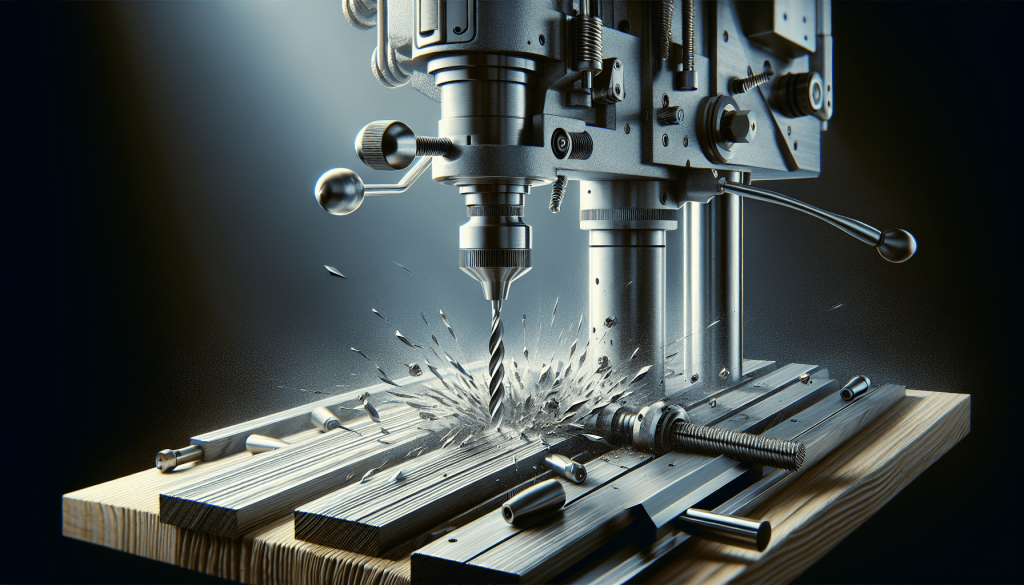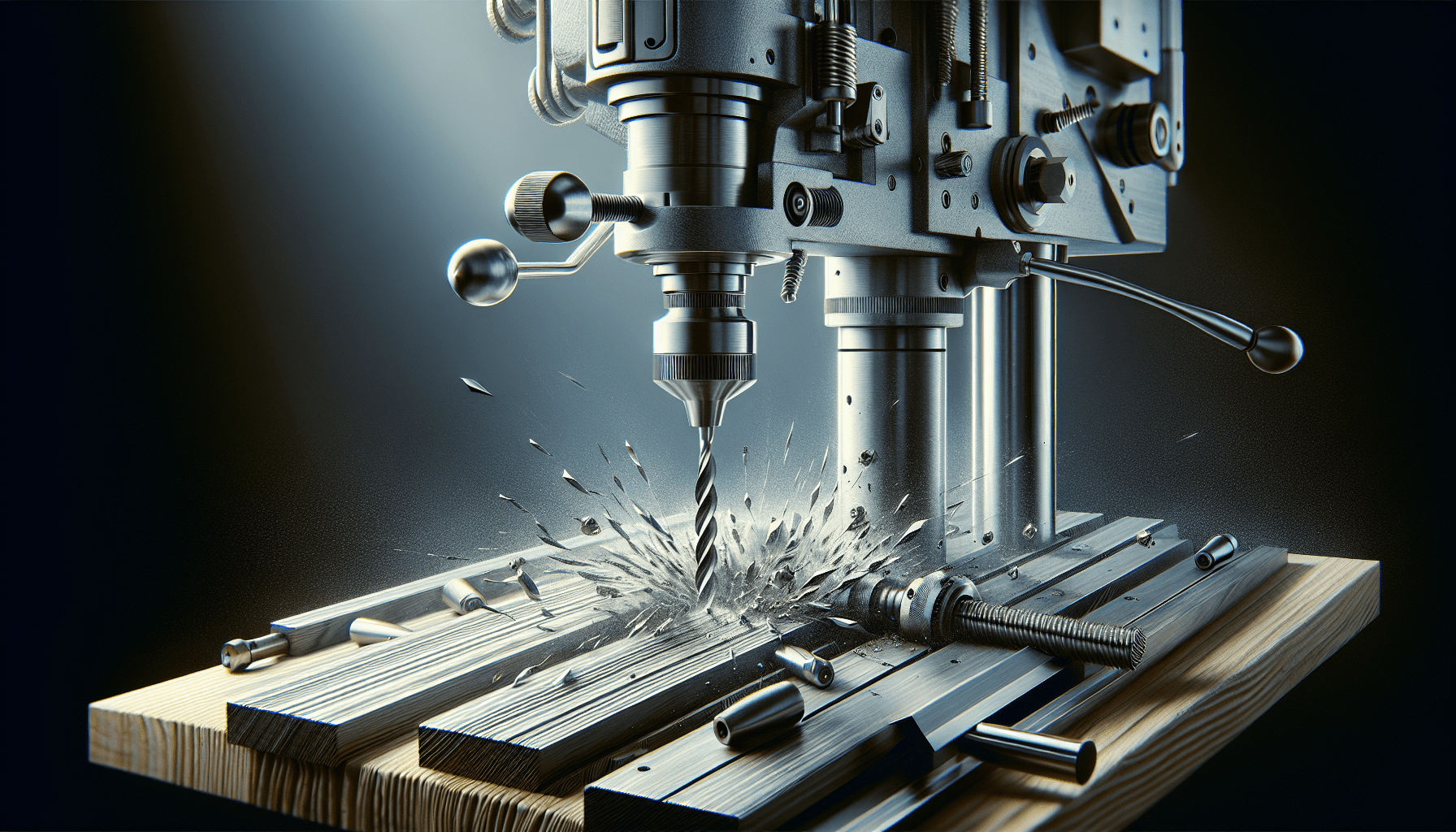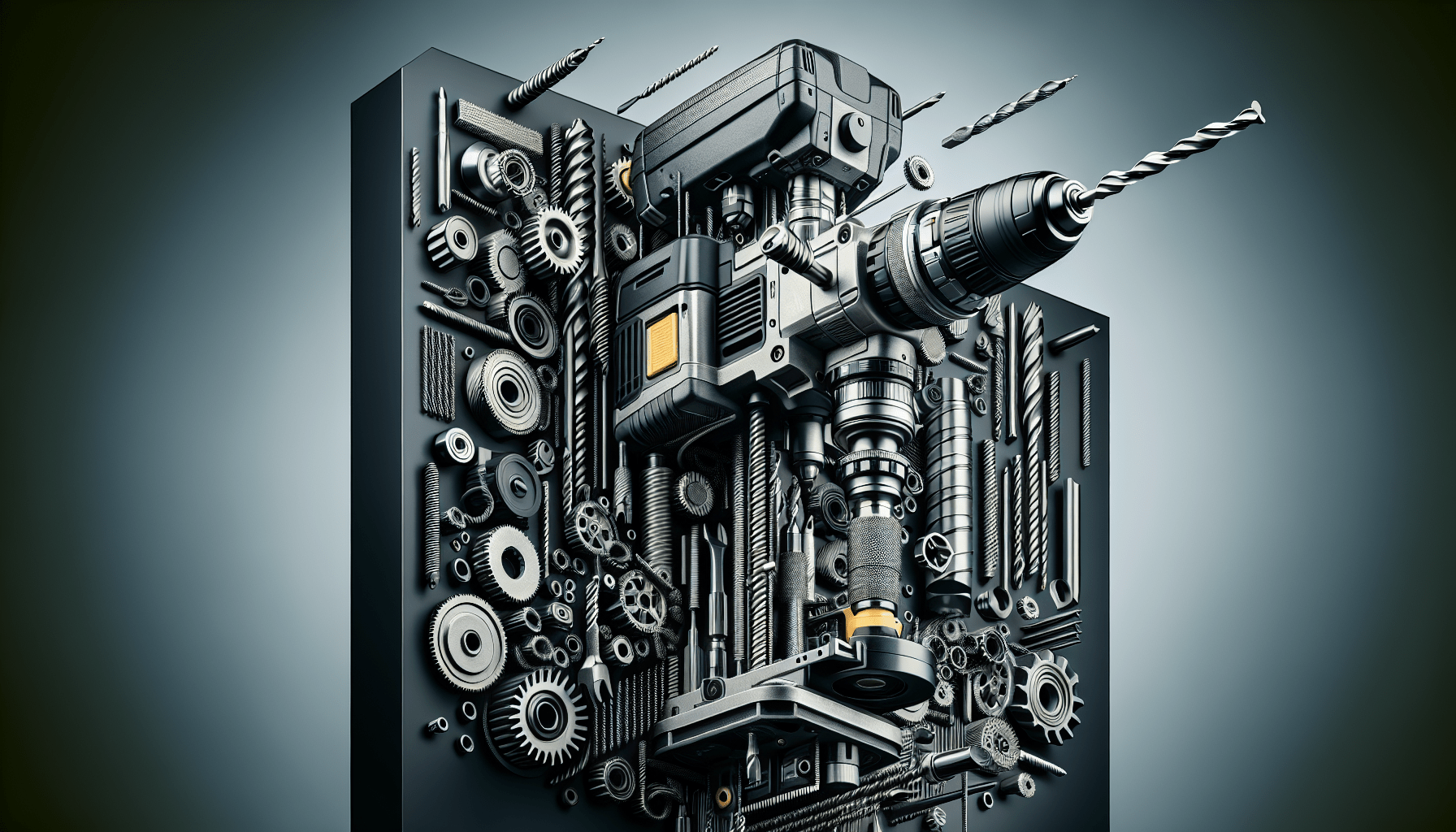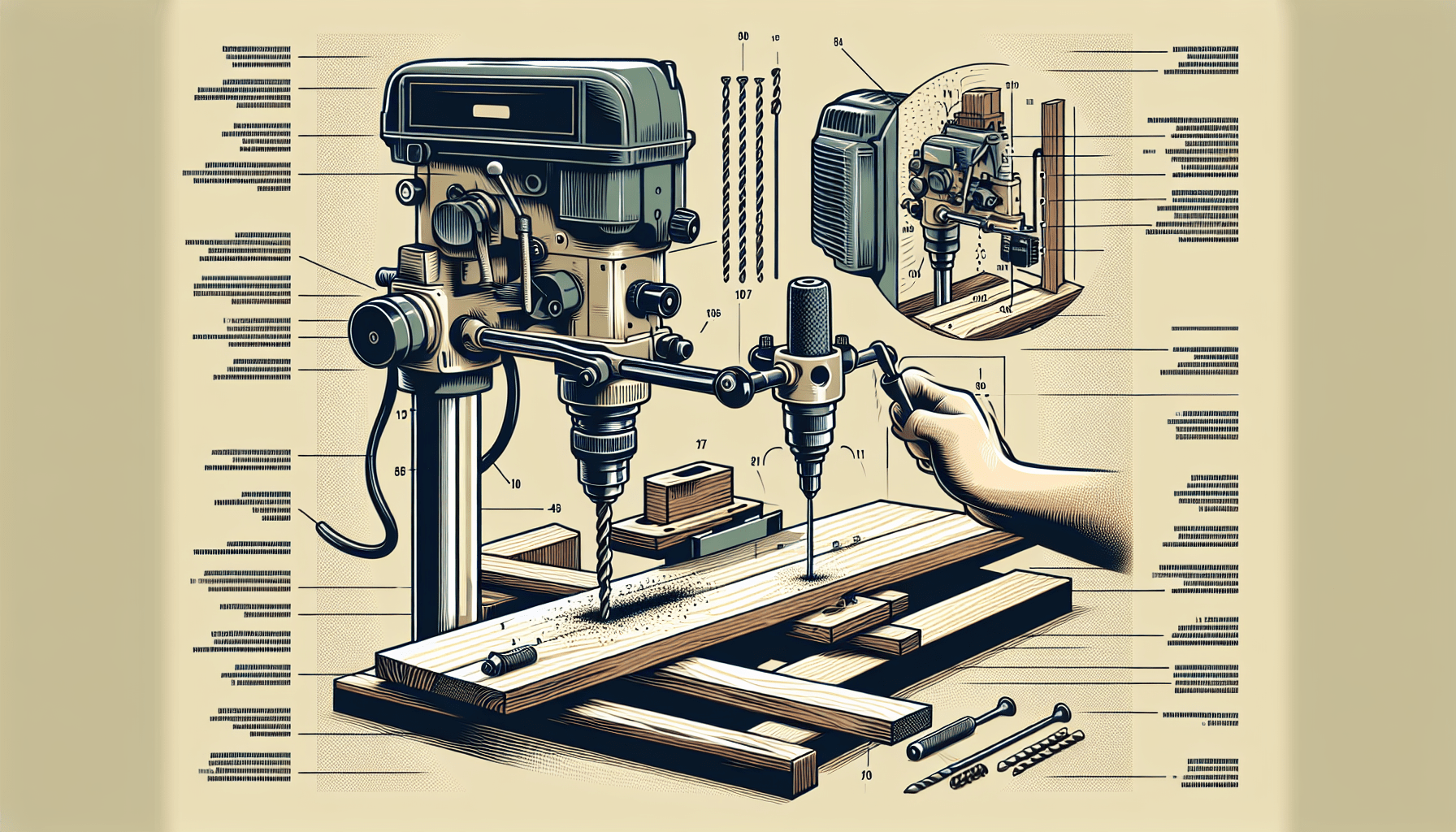Have you ever wondered what people use a column drill for? A column drill, also known as a pillar drill, is a versatile tool that is used by many individuals for a wide range of purposes. From woodworking enthusiasts to professional craftsmen, the column drill offers precision, stability, and power for various drilling tasks. Whether you need to bore holes in metal, wood, or plastic, this tool is a must-have for anyone who values accuracy and efficiency in their projects. In this article, we will explore the different applications of the column drill and discover why it has become such a popular tool among DIYers and professionals alike.

Drilling Holes
Drilling holes is a fundamental skill in various industries and hobbies. Whether you are a professional woodworker, metalworker, construction worker, or simply a DIY enthusiast, understanding how to drill holes properly is essential. In this article, we will explore the different applications of drilling holes in various materials and the techniques involved.
Creating Holes in Wood
Woodworking projects often require the creation of holes for different purposes. From simple joinery work to more complex tasks like creating mortises and tenons, drilling holes in wood is a common practice. When working with wood, it is vital to select the right drill bit size and type for the desired hole. For smaller holes, a twist drill bit or a brad-point bit is suitable. On the other hand, larger holes may require the use of a spade bit or a Forstner bit.
If you are looking to make wooden dowels, drilling holes becomes even more critical. The process involves using a dowel plate or a dowel cutter to shape the dowel. By drilling holes in a larger wooden block and then cutting it into smaller sections, you can create a perfectly shaped dowel.
Making Holes in Metal
Metalworking projects often involve drilling precise holes in various metal materials. This can be challenging due to the hardness and toughness of metals. When drilling through metal, it is essential to use the appropriate drill bits designed specifically for metalworking. High-speed steel (HSS) drill bits or cobalt bits are commonly used for this purpose. They are capable of withstanding the heat generated during the drilling process and can effectively penetrate through metal.
Cutting threads in metal is another application that requires drilling holes. By using a tap and die set, you can create internal or external threads on metal surfaces. This is commonly done in automotive repairs, plumbing installations, and other mechanical projects.
Drilling Holes for Wiring
In construction and home improvement projects, drilling holes for wiring is a crucial step. Whether you are installing electrical outlets, light fixtures, or any other electrical components, running wires through walls and ceilings is essential. This allows for a clean and organized setup. When drilling holes for wiring purposes, it is vital to plan the routing of the wires beforehand. This will help ensure that the holes are drilled in the right locations and at the proper depths.
Woodworking Projects
Woodworking is a popular hobby that involves creating various objects and structures using wood as the primary material. Drilling holes plays a significant role in many woodworking projects, enabling precise joinery, creating mortises and tenons, and even making wooden dowels.
Joinery Work
Joinery work refers to the process of connecting two or more pieces of wood to create a sturdy and cohesive structure. Drilling holes is often necessary to insert screws, nails, or dowels that reinforce the joints. By using a drill and a suitable drill bit, you can create pilot holes that guide the fasteners and prevent the wood from splitting.
Creating Mortises and Tenons
Mortise and tenon joints are one of the oldest and most reliable methods of joining wood pieces together. Drilling holes is a crucial step in creating these joints. The mortise, a square or rectangular hole, is typically made using a drill or a mortising machine. The tenon, a projecting piece of wood, complements the mortise and fits snugly into it. By drilling precise holes for the mortise and tenon, you can ensure a tight and durable joint.
Making Wooden Dowels
Wooden dowels are cylindrical pieces of wood commonly used in various woodworking projects. They serve as pegs or connectors within a structure. To create wooden dowels, the process starts with drilling holes in a larger wooden block. These holes are then cut into smaller sections, resulting in perfectly shaped dowels. This technique requires accuracy and precision to achieve desired dowel sizes.

Metalworking Projects
Metalworking involves shaping and manipulating metal materials to create various objects and structures. Drilling holes is a crucial process in metalworking projects, allowing for the insertion of fasteners, creating threaded holes, and preparing surfaces for other operations.
Cutting Threads
Cutting threads in metal is essential for creating screw connections or facilitating the attachment of various components. This process involves using a tap and die set to create internal or external threads on metal surfaces. Drilling holes of the appropriate size and shape beforehand ensures successful thread cutting.
Reaming Holes
In metalworking, reaming is a process used to smooth and enlarge drilled holes. It helps achieve precise dimensions and ensures proper fitment of fasteners or other components. By using a reamer tool, you can remove any imperfections or rough edges left after drilling the initial hole.
Counterboring and Countersinking
Counterboring and countersinking are techniques used to create recessed holes or cavities in metal surfaces. These holes are designed to accommodate the heads of screws, bolts, or other fasteners, allowing them to sit flush or below the surface. Drilling counterbore holes requires using special drill bits designed for this purpose, while countersinking involves using a countersink bit. These techniques give metalworking projects a more polished and professional look.
Construction and Home Improvement
Drilling holes is a common practice in construction and home improvement projects. Whether you are installing cabinets, shelves, or wall mounts, drilling precise and properly placed holes is crucial for achieving a secure and functional result.
Installing Cabinets or Shelves
When installing cabinets or shelves, drilling holes is necessary to attach them to walls or other surfaces. By using a drill and the appropriate drill bit, you can create pilot holes that guide the screws or anchors. This ensures a secure and stable installation, preventing the cabinets or shelves from loosening or falling over time.
Inserting Anchors for Wall Mounts
Wall mounts for televisions, pictures, or other objects often require the insertion of anchors into walls. These anchors provide additional support and prevent damage to the walls. Drilling holes in the wall at precise locations allows for the insertion of anchors before attaching the wall mounts. This ensures a secure and reliable mounting solution.
Building Furniture
When building furniture, drilling holes is often necessary to connect different components or attach various parts together. This is especially true for flat-pack furniture that requires assembly. Drilling holes and using appropriate fasteners, such as screws or dowels, facilitates a straightforward and sturdy construction process.

Mechanical Repairs
Mechanical repairs involve fixing or replacing components in machinery, engines, or other mechanical systems. Drilling holes is a useful technique in this field, allowing for the removal of broken bolts or screws, repairing engine parts, and working with tough or resistant materials.
Removing Broken Bolts or Screws
Broken bolts or screws can be a nightmare to deal with, but drilling holes can provide a solution. By using a drill and a suitable drill bit, you can create a hole in the center of the broken bolt or screw. This hole serves as a guide for an extractor tool or an easy-out, which can then be used to grip and remove the broken piece.
Repairing Engine Parts
In automotive or machinery repairs, drilling holes can be necessary for fixing engine parts or other components. For example, if a cylinder head or engine block requires repair, drilling holes may be required to remove damaged sections or install new components. It is crucial to use the correct drill bits and techniques to avoid further damage and ensure the repaired parts function properly.
Drilling through Tough Materials
Certain mechanical repairs involve working with tough or resistant materials, such as hardened steel or concrete. Drilling holes in these materials requires the use of specialized drill bits designed for the task. For example, carbide-tipped or diamond-tipped drill bits can provide the necessary cutting power to penetrate these challenging materials.
Crafting and DIY Projects
Crafting and DIY projects offer endless opportunities for creativity and personal expression. Drilling holes is a valuable technique in these endeavors, allowing for the creation of wooden crafts, DIY furniture, and even jewelry design.
Creating Wooden Crafts
Woodworking crafts, such as decorative items, toys, or small furniture pieces, often require drilling holes for assembly or embellishments. By using a drill and the appropriate drill bits, you can add intricate details, create joints, or insert decorative elements to enhance the beauty and functionality of your wooden crafts.
Building DIY Furniture
DIY furniture projects have gained popularity in recent years, as they offer cost-effective and personalized alternatives to store-bought pieces. Drilling holes is an essential part of the assembly process, enabling the connection of different components or the insertion of hardware, such as hinges or drawer slides. By mastering the art of drilling holes, you can create unique and functional furniture items for your home.
Designing Jewelry
Jewelry making often involves drilling precise holes in various materials, such as beads, gemstones, or metal components. By using a small handheld drill or a rotary tool with a flex shaft attachment, you can create holes for stringing beads, setting gemstones, or attaching findings. This allows you to unleash your creativity and design custom jewelry pieces that reflect your style and personality.

Artistic and Sculptural Applications
Drilling holes can also have artistic and sculptural applications. Whether you are creating intricate designs, carving wood or stone, or sculpting clay or ceramic, drilling holes can add depth, texture, and visual interest to your artwork.
Creating Intricate Designs
Drilling holes in various materials can enable the creation of intricate designs with a unique and captivating visual effect. By strategically placing holes and working with different sizes and shapes, you can achieve stunning patterns and artistic expressions. This technique is commonly used in woodworking, metalworking, and even mixed media art projects.
Carving Wood or Stone
Wood and stone carving often involves drilling holes as a preliminary step. These holes define the boundaries of the carved areas and allow for the removal of excess material. By using a drill and specialized carving attachments or bits, you can achieve detail and precision in your carving projects.
Sculpting Clay or Ceramic
When working with clay or ceramic, drilling holes can serve both functional and aesthetic purposes. For functional objects like vases or planters, drainage holes are essential to prevent water from accumulating. Aesthetically, drilling holes in clay or ceramic sculptures can create unique textures or showcase the translucency of the material when illuminated. It is crucial to use appropriate drill bits or carving tools suitable for clay or ceramic to avoid cracking or damaging the material.
Metal Fabrication
Metal fabrication involves shaping and manipulating metal materials to create structures, parts, or components. Drilling holes plays a vital role in metal fabrication processes, enabling the creation of precision holes in metal sheets, fabricating metal structures, and working on automotive projects.
Making Precision Holes in Metal Sheets
In metal fabrication, precision is paramount. Whether you are creating metal sheets for architectural purposes or fabricating intricate metal components, drilling precision holes is essential. By using specialized drill bits, clamping systems, and accurate measurements, you can achieve clean and perfectly aligned holes in metal sheets.
Fabricating Metal Structures
Drilling holes is a fundamental process in fabricating metal structures, such as frames, supports, or brackets. These holes allow for the connection of various metal components, ensuring structural integrity and stability. By accurately drilling the holes and choosing suitable fasteners, you can create robust and durable metal structures.
Working on Automotive Projects
Automotive projects often involve working with metal materials, whether it is repairing or modifying vehicles. Drilling holes is required for tasks like installing new automotive components, creating custom brackets or mounts, or even fabricating metal body panels. By using the appropriate drill bits and techniques, you can accomplish these projects efficiently and effectively.

Installing Fixtures
Installing fixtures is a common task in both residential and commercial settings. Whether you need to mount light fixtures, attach railing or balusters, or install cabinets or drawers, drilling precise and properly placed holes is crucial for a secure and professional installation.
Mounting Light Fixtures
When it comes to mounting light fixtures, drilling holes is an essential step. By using a drill and the correct drill bit, you can create holes to accommodate the mounting hardware or wiring connections. Precise hole placement ensures that the light fixtures are securely attached to the desired location, providing proper illumination and enhancing the overall aesthetics of the space.
Attaching Railing or Balusters
Installing railing or balusters, whether for stairs, balconies, or decks, requires drilling precise holes. These holes allow for the insertion of railing posts or balusters, providing safety and stability to the structure. By following proper measurements and alignment guidelines, you can create evenly spaced and secure connections.
Installing Cabinets or Drawers
Drilling holes is an essential part of installing cabinets or drawers. By creating pilot holes, you can ensure accurate placement of screws or other fasteners, preventing the wood from splitting or the hardware from becoming misaligned. Properly installed cabinets and drawers offer functional storage solutions and contribute to a well-organized living or working space.
Jewelry Making
Jewelry making is a creative and intricate craft that often involves drilling holes in various materials. From creating precise holes in beads for stringing to drilling gemstones for setting, drilling techniques are essential in the world of jewelry design.
Creating Precise Holes in Beads
Creating jewelry with beads requires drilling precise and clean holes. By using a small handheld drill or a rotary tool with a flex shaft attachment, you can drill holes in beads of various materials, such as glass, gemstones, or pearls. Proper hole placement and size are critical for ensuring smooth stringing and secure connections in your jewelry pieces.
Drilling Gemstones for Setting
Drilling gemstones can be a delicate and meticulous process. Whether you are creating a pendant, earring, or other jewelry pieces, drilling holes in gemstones allows for setting or attaching them to the jewelry base. It is essential to choose the appropriate drill bits and techniques that minimize the risk of damage to the gemstone.
Crafting Metal Jewelry
Drilling holes is also necessary when crafting metal jewelry pieces. Whether it involves creating openings for jump rings, bail attachments, or intricate designs, drilling precise holes in metal adds versatility and dimension to your jewelry designs. By utilizing proper drill bits and techniques, you can incorporate unique and personalized elements into your metal jewelry creations.
In conclusion, drilling holes is a versatile and essential technique used in numerous industries and hobbies. From woodworking and metalworking to construction, mechanical repairs, crafting, and jewelry making, drilling holes allows for precise connections, functional installations, and creative expressions. By understanding the different applications of drilling holes and mastering the techniques involved, you can enhance your skills and achieve remarkable results in your projects. So grab your drill, select the appropriate drill bits, and start exploring the endless possibilities that drilling holes can offer. Happy drilling!



